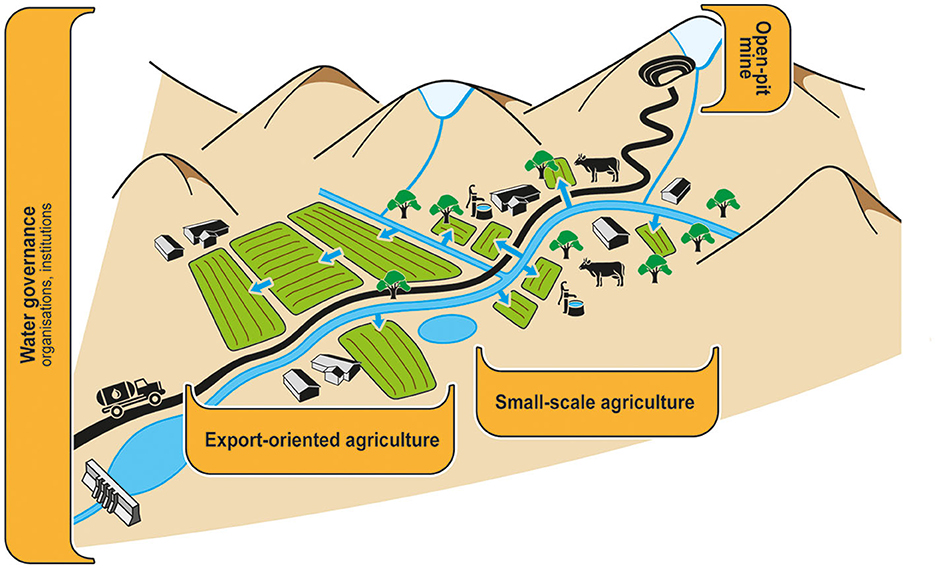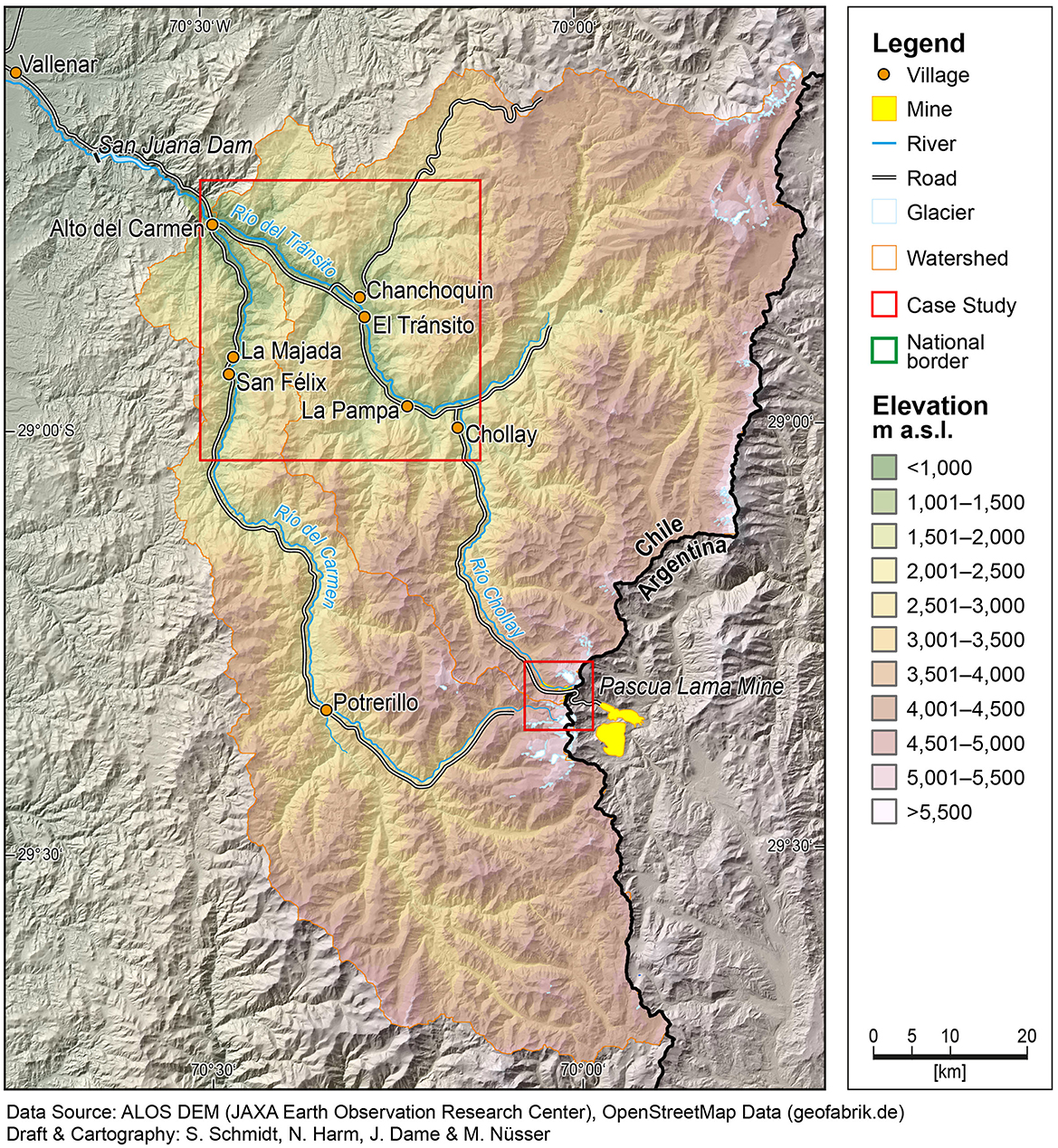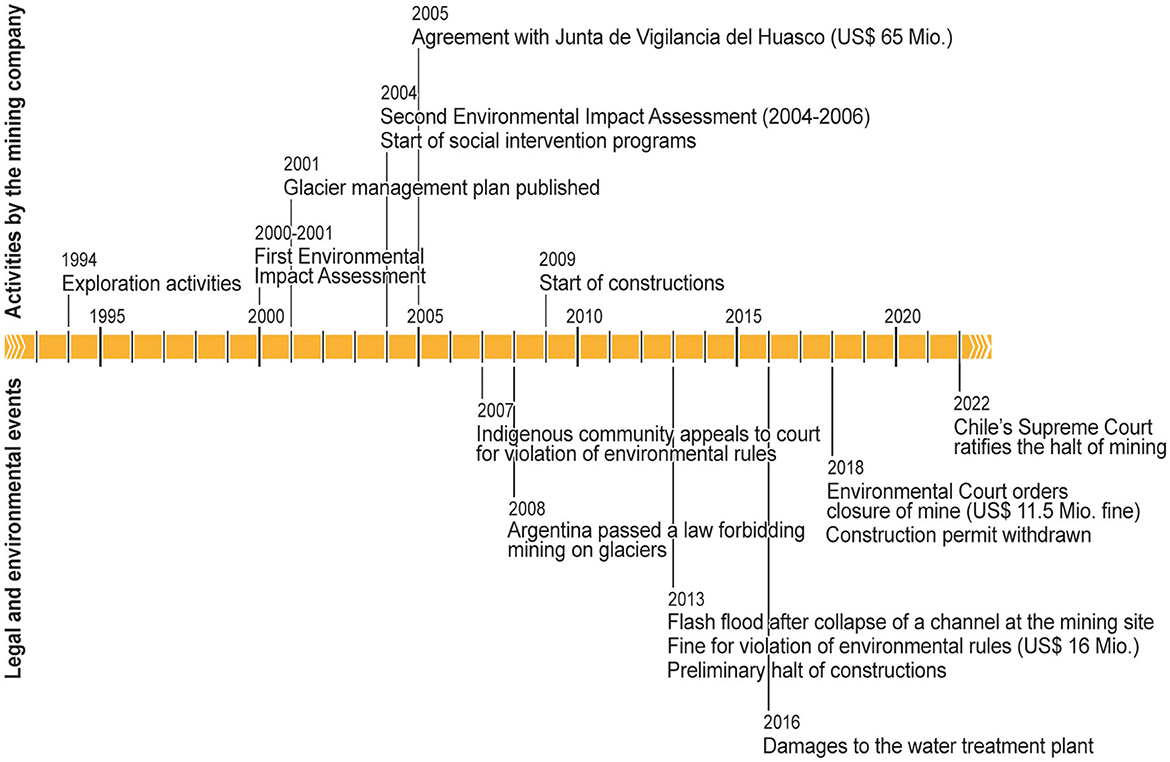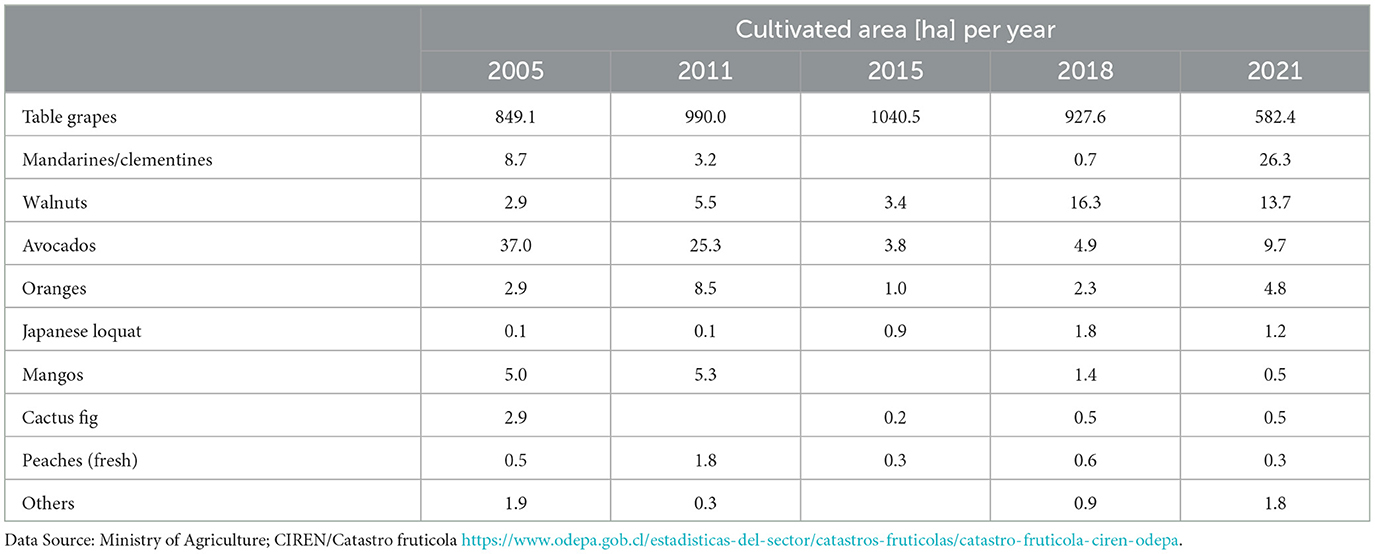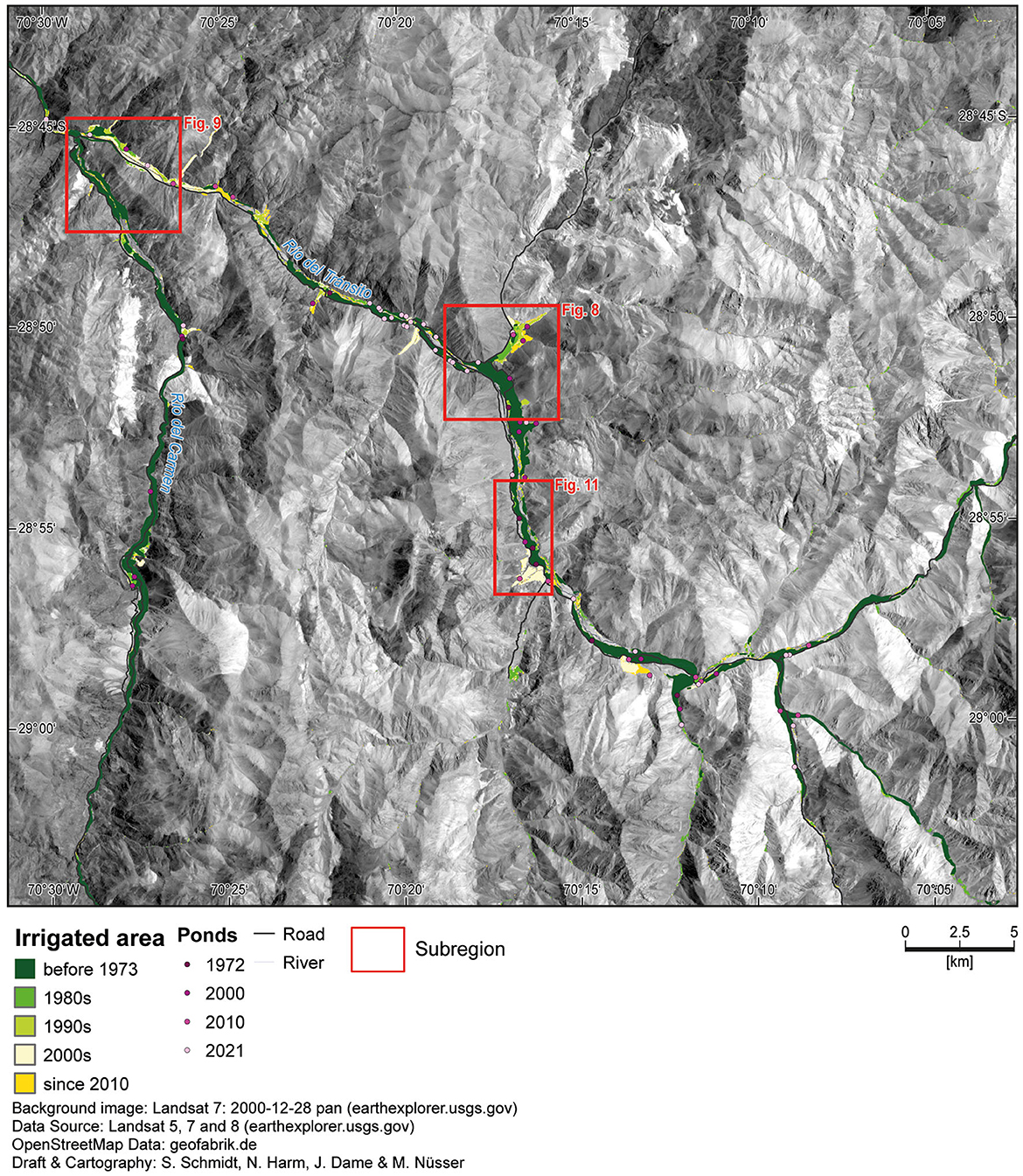- 1Department of Geography, South Asia Institute (SAI), Heidelberg University, Heidelberg, Germany
- 2Institute of Geography, University of Bonn, Bonn, Germany
- 3Heidelberg Center for the Environment (HCE), Heidelberg University, Heidelberg, Germany
In arid regions of north-central Chile, mining activities and agricultural land use changes lead to competing water demands, water insecurity, and related conflicts. Different local and external user groups rely on the scarce water resources. This case study investigates socio-hydrological transformations in the upper Huasco valley. It builds on a mixed method approach that combines remote sensing assessments (Corona, Landsat, Sentinel-2) with a set of social science methods including interviews and an analysis of Twitter tweets. Against the backdrop of the recent mega drought, results show that the upper Huasco valley faces adverse environmental impacts and conflicts over mining activities as well as an expansion of export-oriented agriculture. While water availability largely depends on the cryosphere, remote sensing analyses show a drastic glacier decrease in the vicinity of the mining project, where three glaciers completely disappeared since 2000. Furthermore, an expansion of the cultivated area from 2,000 ha in the 1990s to about 3,210 ha occurred in the 2000s. Agricultural expansion has come to a halt and only a slight increase of 100 ha can be detected over the last decade. Interview and social media data show local concerns and discourses on issues of water scarcity and quality related to these land use changes. The study stresses the necessity of integrative assessments for a better understanding of water scarcity and water-related conflicts. Equitable water governance in climate-sensitive areas requires contextualizing land use changes and the precarious drinking water situation from a socio-hydrological perspective.
1. Introduction
The Environmental Justice Atlas lists a total of 60 environmental conflicts in Chile, of which ~73% are related to mineral extraction and water issues (EJAtlas, 2022). Problems of water scarcity, water insecurity and deficient water quality in the drylands of north-central Chile are generally affected by significant climatic variability, including a prolonged drought period since 2010 (Muñoz et al., 2020). Moreover, various impacts of land use systems in different parts of the country, especially agriculture and mining together with specific aspects of water legislation critically affect precarious human-water relations (Larraín and Schaeffer, 2015). Increasing pressure on scarce water resources leads to conflicts between different water user groups, such as agricultural producers, mining companies, and local communities across the region.
The legal base of water use in Chile is regulated in the Water Code, which was passed in 1981 under the dictatorship of Augusto Pinochet (Bauer, 1998, 2015; Budds, 2013, 2020). The aims of the Water Code have been the promotion of export-oriented agriculture, mining, and energy production through hydropower. Following a neoliberal logic, its guiding principle is the complete privatization of water rights and its concurrent decoupling from land ownership. Provided there are no restrictions for a catchment area and no objections from third parties, water rights are granted free of charge by the responsible National Water Directorate (Dirección General de Aguas; DGA) and these titles are subsequently tradable and inheritable. The rights to use surface water and groundwater are separate despite the connectivity of these hydrological systems. Several studies on water conflicts and governance in Chile have proven severe inequalities with accumulation of water rights by powerful actors and corresponding lack of water access by less influential groups and communities (Budds, 2009, 2020; Prieto, 2015, 2016; Usón et al., 2017). These socio-political interventions have been accompanied by adverse environmental impacts. Critiques have led to minor modifications of the Water Code in 2005, which included imposing fees for non-use of water rights to reduce speculation (Budds, 2013).
These characteristic regional development trajectories raise a number of questions, which require integrated conceptual approaches (Wesselink et al., 2017). Since 2012, the research field of socio-hydrology includes socioeconomic dynamics in the analysis of human-water interactions (Nüsser et al., 2012; Sivapalan et al., 2012). Mainly advanced by authors with a background in the natural or engineering sciences, socio-hydrology understands water and society as coupled systems characterized by specific interactions and feedback loops (Sivapalan et al., 2012; Sivapalan, 2015; Troy et al., 2015; Blair and Buytaert, 2016; Ross and Chang, 2020). Causal relationships are mostly based on pathways, dependencies and watershed modeling to assess water-related processes, associated risks (Viglione et al., 2014; Di Baldassarre, 2017; Schmidt et al., 2020) and future scenarios (Pande and Savenije, 2016; Pande and Sivapalan, 2017; Roobavannan et al., 2017). An important aspect of socio-hydrological studies is the consideration of processes at different temporal and spatial scales (Sivapalan et al., 2014), in some cases with a focus on the particularities of mountain environments (Nüsser, 2017).
Assessments often rely on quantitative data, which are increasingly complemented by qualitative methods. Socio-hydrology has frequently been criticized for its strong reliance on numerical models and its neglect of the plurality of human agency, perceptions and values (Wesselink et al., 2017). In a similar vein, critical comments refer to a disregard of local or indigenous knowledge on water-related topics (Troy et al., 2015; Nüsser and Baghel, 2016) and “non-scientific” meanings of water (Krueger et al., 2016). Despite ongoing conceptual debates and advances, the integration of social science approaches and methods into socio-hydrology remains a major research challenge. Authors argue for more balanced perspectives in interdisciplinary human-water studies and combined methodological approaches to adequately address human agency and governance (Di Baldassarre, 2017; Haeffner et al., 2021; Yu et al., 2022).
In the social sciences, the term socio-hydrology is less frequently used. Instead, alternative framings of integrated concepts have been proposed as hydrosocial approaches, which are mainly rooted in critical geography, political ecology and science and technology studies (Swyngedouw, 1997; Bakker, 2009). Their focus is the politicized character of water governance related to power asymmetries and inequalities in resource access. Conceptually, the hydrosocial cycle (Linton and Budds, 2014) departs from a relational perspective to overcome the dualism between nature and culture. Water is understood as a hybrid where nature and society constantly co-produce each other. Typical fields of research are irrigation and supply infrastructures, and the uneven access to water, with several regional examples from Chile (Boelens, 2014; Linton and Budds, 2014; Prieto, 2015; Usón et al., 2017). The hybrid nature of human-water relations has also been conceptualized as hydrosocial territories (Boelens et al., 2016) or explored under the umbrella of waterscapes to investigate the interrelated nature of water, power and capital which produce uneven socio-ecological conditions (Budds and Hinojosa, 2012; Karpouzoglou and Vij, 2017; Flaminio et al., 2022). However, several hydrosocial studies have not amply addressed the hydrological dimensions at the human-water interface.
Under the umbrella term of socio-hydrology, water management has been investigated in specific historical, cultural, economic and environmental settings. Especially mountain regions are characterized by complex water-related processes and social constellations, leading to site-specific particularities (Carey et al., 2017; Nüsser and Schmidt, 2017; Nüsser et al., 2019b). Therefore, case study approaches are indispensable to get deeper insights into entangled socio-hydrological interactions. As in previous studies (Nüsser et al., 2012, 2019a; Parveen et al., 2015), the socio-hydrological approach is used as a framework to address these complex relations across different spatial, temporal and social scales. An improved understanding of mountain waterscapes, that encompasses spatial, material, and discursive facets of human-water dynamics, requires identification of the main hydrological components and actor constellations. In the case of the upper Huasco valley, socio-hydrological interactions are characterized by water abstraction from cryosphere runoff for mining and agriculture in the context of neo-liberal water governance (Figure 1).
Departing from an integrated concept of mountain waterscapes, this article investigates socio-hydrological transformations in the upper Huasco valley against the background of mining impacts and agricultural changes, which increase pressure on scarce water resources and are a potential threat to water quality. The case study aptly exemplifies the impact of the expansion of extractivism and agriculture on local water resources. Since the early 2000s, the upper Huasco valley has received international attention due to the conflict over the construction and operation of the Pascua Lama open-pit mine, for the extraction of gold, silver and copper. In Chile, the economic relevance of the mining sector is large, with a share of 14.6% of the GDP in 2021. The country is a world leader in copper production with a volume of over 5580 tons in 2021 and belongs to the top 5 gold-producing countries in the world (SERNAGEOMIN, 2022, p. 9). Metal extraction is always associated with a high demand for water and energy as well as a risk of water contamination by toxic waste products from mining operations (Budds and Hinojosa, 2012; Valdés-Pineda et al., 2014; Zanetta-Colombo et al., 2022). At the same time, the Huasco valley is characterized by a mix of small-scale and export-oriented agricultural land use. In Chile, the area under fruit crop cultivation has been enlarged significantly and fruit exports have increased by 18% between 2008 and 2018. Chile is the global leader in table grape exports and ranks second in blueberry and cherry exports (ODEPA, 2019). Agriculture is the most important water consuming economic sector in the country, accounting for about 75% of the total water demand (Oyarzún et al., 2008). While export-oriented fruit cultivation amounts to 60% of the total agricultural production, agriculture only contributes to < 3% of the Chilean GDP, but it retains primary importance for rural livelihoods (ODEPA, 2019).
Previous studies on the Huasco valley have mostly focused on distinct aspects, such as the prominent conflict over the Pascua Lama mining project (Urkidi, 2010; Urkidi and Walter, 2011; Bottaro et al., 2014; Li, 2018), water quality (Strauch et al., 2009; Zang et al., 2018) and glacier changes in the upper catchment (Nicholson et al., 2009; Rabatel et al., 2011; Staub and Munos, 2016; Hess et al., 2020). In the present study, we analyse and explore the multi-dimensional land use changes from a socio-hydrological perspective using quantitative and qualitative methods. After an introduction to the study area, a description of the empirical social science and remote sensing methods is given. The precarious drinking water situation is taken as a starting point for an assessment of recent land use changes in the context of mining and agricultural expansion and related discourses over water scarcity and quality. Own results are contextualized in a broader literature review.
2. Study area
The Huasco valley stretches from the main Andean Cordillera to the Pacific Ocean. The main range of the Andes marks the border to Argentina and exceeds heights of 6,000 m a.s.l. Located about 200 km to the south of Ojos del Salado (6,893 m a.s.l.), Chile's highest peak, the Huasco valley is part of the transition zone between the arid Norte Chico and the hyperarid Norte Grande with the Atacama Desert. The average annual precipitation amounts to 49 mm and the mean annual temperature reaches 17.8 °C at Santa Juana station (560 m a.s.l.) downstream of the town Alto del Carmen (1965–2015; DGA, 2016). Predominantly influenced by westerlies, about 81–85% of the annual precipitation occurs during the austral winter between May and August (Salas et al., 2016). During the dry summer months and in times of drought, the Rìo Huasco is almost exclusively fed by meltwater from the cryosphere (Falvey and Garreaud, 2007; Favier et al., 2009; Vicuña et al., 2012; Azócar et al., 2017). The glacierized area in the upper catchment amounts to more than 24 km2 in the year 2016, while 80% of the ice-bodies are smaller than 0.1 km2 (Hess et al., 2020), often classified as glacierets or névés (Nicholson et al., 2009).
Annual precipitation exhibits pronounced interannual variability influenced by El Niño Southern Oscillations (ENSO) (Fiebig-Wittmaack et al., 2012; Masiokas et al., 2020). Rare extreme summer precipitation events regularly cause floods and landslides, such as in 2015 with heavy precipitation and flooding in the Huasco watershed (Salas et al., 2016; Meltzer et al., 2021). Recurring and often extensive drought periods adversely affect water resources. Since 2010, a so-called mega drought has affected Chile, which is the longest period of continuous rainfall deficits ever recorded (Garreaud et al., 2020). This unprecedented event has aggravated water scarcity in different parts of the country (Aldunce et al., 2017; Muñoz et al., 2020).
The case study examines the upper catchment of Río Huasco covering an area of about 7,000 km2, upstream of the town Alto del Carmen at the confluence of the two main tributaries Río del Carmen from the southeast and Río del Tránsito from the northeast at an elevation of 815 m a.s.l. (Figure 2). Characterized by steep slopes, the topography of the upper Huasco valley (Huasco Alto) limits the suitability for settlements and agricultural areas (Figure 3). The population of the municipality of Alto del Carmen, which comprises the upper Huasco valley, amounts to 5,754 inhabitants in 2021 living in dispersed rural settlements (BCN, 2021). Approximately 20% are members of the Diaguita community, officially recognized as an indigenous community since 2006 (Molina Otárola and Campos Muñoz, 2017). Irrigated agriculture along the riverbed, where table grapes, avocados, and grapes for viniculture are cultivated as main crops, is the most important income source. Between 2009 and 2013, employment in the agricultural sector increased from 52% to 68% (BCN, 2021). Population growth and steadily expanding irrigation by export-oriented agricultural companies contribute to rising water demand (Wagnitz et al., 2014).
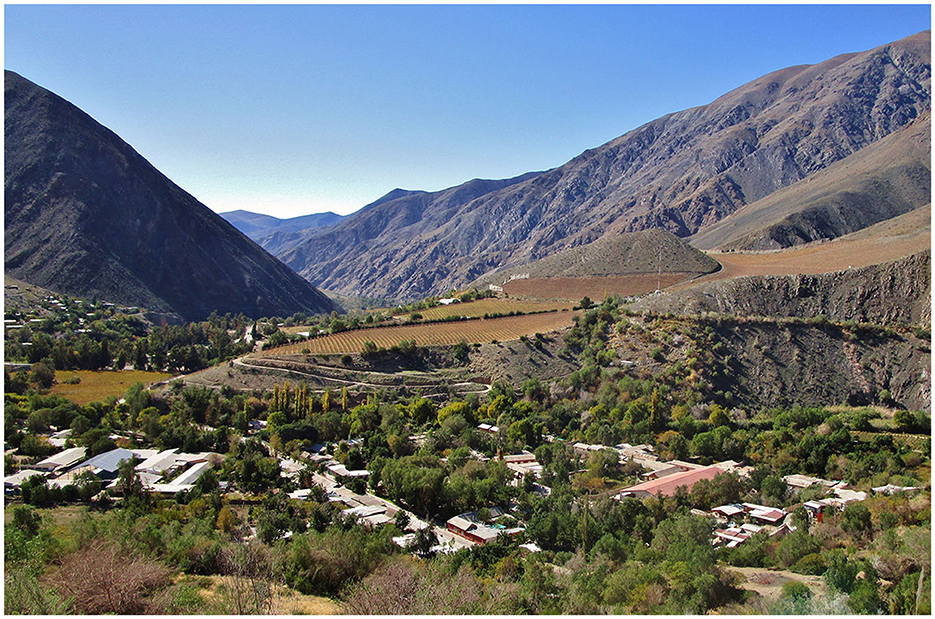
Figure 3. Rural settlements and small-scale (in the foreground) as well as large-scale (in the background) agriculture in the El Tránsito valley (Photo: Carina Zang, 27 May 2015).
3. Material and methods
To assess the complex dynamics and processes in the upper Huasco waterscape, this study used a set of complementary methods. Interview and survey data from different subprojects within a wider research project on environment and health in arid regions have been reanalysed and complemented by an analysis of social media data and a remote sensing analysis. Qualitative interviews with stakeholders were conducted between 2014 and 2016 to gain information on water use, perception of water quality, water governance, water supply, and agricultural practices. Relevant place-based and non-place-based stakeholders included farmers, policy makers, researchers, NGO members, employees of mining or agribusiness companies (with more than 20 year-round employees), independent consultants and members of the Rural Drinking Water Committees (Comité de Agua Potable Rural; CAPR). Interviews were conducted in Spanish by a German PhD student who was in several occasions accompanied by a Chilean research assistant from Santiago. Interviews have not been recorded digitally. We assessed the data based on Kuckartz (2014) qualitative content analysis using thematic analysis as the basic method. The analysis of qualitative interview data was performed software-supported using the program MaxQDA, complemented by information from official statistical data, (unpublished) reports, and media reports. For detailed information on water demand, water quality, (public) health issues and drinking water systems, a standardized household survey was conducted in 25 settlements of the upper Huasco valley. The survey was realized within the wider project context by a German medical student and a Chilean research assistant from Santiago and also included sections on a flood event in 2015 and risk adaptation strategies (see Annex 3 in Meltzer et al., 2021). The questionnaire covered data from 262 households. Random sampling was implemented in settlements with more than 20 households, while solitary houses and households in smaller hamlets were all approached. We aimed for an even distribution over the two main tributary valleys to ensure representative results. In total, 342 households were approached and 262 interviews were realized. A pre-test was performed a few weeks prior to the data collection in the same region, but outside the actual study area. All interviews were carried out in Spanish. Written informed consent to participate in the questionnaire survey was provided by the participants.
Both researchers who conducted the interviews were female, European, young academics. They spent several months in the study area and were not actively involved in the conflictive situation. The study design was discussed with researchers at the Heidelberg Center for Latin America in Santiago de Chile. Both research assistants were female, Chilean, young graduates from a well-known university in Santiago and paid by the project. They also helped to cross-check cultural appropriateness and wording of the survey. This can have implications on all steps in the research process, including the participation of households and interview partners as well as the production of knowledge.
The collected interview and survey data were combined with an analysis of Twitter tweets for a broader assessment of views from the communities and local as well as non-local stakeholders. Moreover, it allowed to cover a longer time-span even during the Covid pandemic. In social media networks, people express their views, including political ones, openly. Although social media analyses are less inclusive than other social research approaches, given the limitations in access for marginalized people (Ash et al., 2018; Fearnley and Fyfe, 2018; Buckingham et al., 2020), the method has untapped potential in combination with other social science methods. Twitter has been selected as one of the most popular social media sites providing a potentially large set of data (Fearnley and Fyfe, 2018). It provides an interesting additional perspective by detecting main arguments in the discourses over water by local and non-local Twitter users. For this analysis, all tweets with the hashtags agua/water, glaciares/glaciers, sequía/drought (to capture tweets in Spanish and English) combined with #pascualama and #huasco (to restrict tweets to the study area) have been extracted from the database Twitter between 2013 (the halt of the Pascua Lama mining project) and 2022. Results were subsequently analyzed using the software MaxQDA, while individual users were anonymised.
The results from social research methods were combined with remote sensing approaches for rigorous triangulation. Multi-temporal satellite imagery (Corona, Landsat and Sentinel-2) were used to map agricultural areas (Table 1). Using a standardized semi-automatic approach based on a Normalized Difference Vegetation Index (NDVI) NDVI = (NIR – R) / (NIR + R), dense irrigated vegetation cover was mapped on Landsat images (path: 233, row: 80) taken in December by applying a threshold of NDVI > 0.4. In order to investigate the expansion of agricultural area, the classified Landsat images were combined on a decadal basis (1984–1989, 1990–1999, 2000–2009, 2010–2021). To reduce the effect of misclassified pixels caused by image errors, pixels which were classified as vegetation covered on only one single dataset were discarded. In order to extend the observation period, a panchromatic Corona image from 1973 was co-registered to the Landsat images. In a second step, Sentinel 2 data were used to investigate the impact of the current mega drought (Garreaud et al., 2020) on the agricultural production. The classified images (NDVI > 0.4) were summarized into three classes (cultivated in ≥ 6 years; cultivated in 3–5 years; cultivated ≤ 2 years between 2015 and 2021).

Table 1. Satellite data used in this study (pan, panchromatic; VIS, visible; NIR, Near Infrared; SWIR, Shortwave Infrared).
To identify glacier changes in the vicinity of the Pascua Lama mine project, cloud-free satellite imagery from the end of the ablation period were used to map the ice-covered area in 1986, 2000, and 2022. A standardized semi-automatic threshold approach based on the red/shortwave infrared band ratio was applied to delineate glacier boundaries, as ice and snow are characterized by a high reflection in visible light and high absorption in the shortwave infrared range (Paul et al., 2009; Hess et al., 2020). The classified ice-covered areas were transformed into vector data and objects smaller than 0.01 km2 were deleted. The infrastructure of the Pascua Lama mine (roads, compounds, tailings) were digitized manually for different observation periods from satellite data.
4. Results and discussion
In the context of the recent mega drought, the Chilean Water Directorate (DGA) declared the upper Huasco catchment as a water scarcity zone in the summer 2021/2022 (MOP, 2022). The area is facing problems of water provision for human consumption and irrigation purposes. Drinking water supply in the upper Huasco valley depends on groundwater. As in other rural areas of Chile, drinking water supply is mainly organized by local Agua Potable Rural committees (CAPR), collective institutions initiated in 1964. An CAPR is composed of elected community members, who are assisted by government organizations (Donoso and Vicuña, 2016). Each of the 20 CAPRs in the upper Huasco valley is responsible for infrastructure maintenance and water quality monitoring. Their size varies between 45 and 329 households covering about 95% of the total population (MOP, 2016). These rural institutions are independent in terms of administration, finances, and technical aspects. As some local CAPRs have reported in interviews, financial limitations to maintain and extend infrastructure for water provision, about 120 households (higher numbers after floods or during droughts) depend on drinking water supply by trucks, which are organized by the municipality Alto del Carmen. These trucks are filled from different wells in the upper Huasco valley. The declared drinking water provided by CAPRs and trucks is not only used for household purposes, but also for irrigation (42% of the surveyed households, n = 262) and livestock (32% of the surveyed households). Only few households either depend on own bore wells, springs, or additional water from neighbors.
Despite the crucial role of groundwater for drinking water supply and the fact that several studies have examined aquifers, their extensions and interconnections (e.g., DGA, 2004; CNR, 2006; CAZALAC, 2012), members of local CAPRs stated that they regularly have no or only little information on groundwater systems and recharge. In consequence and in addition to the lack of a public register of bore wells, the CAPRs do not know how many farmers access the same aquifer and how much water will be available. In addition, major concerns by the local population brought forward in interviews are negative impacts of mining activities on water quality and diverse adaptation needs in agricultural land use. The following sections contextualize the prominent mining conflict with regional water governance and agricultural land use change to shed light on the entangled socio-hydrological dynamics in the waterscape.
4.1. Mining
Since the 2000s, the Huasco valley has become a prominent site of environmental conflicts due to the construction of the Pascua Lama open pit mine located between 3,800 and 5,200 m a.s.l. at the border between Chile and Argentina (Figure 2). The mining project is an important factor in the socio-hydrological setting due to its proximity to glaciers of the main Andean range, which are key to regional water supply. Following initial exploration activities in the mid-1990s, Pascua Lama has been planned as a binational mining project of Chile and Argentina under the lead of the Canadian Barrick Gold company. The original plan envisaged to extract about 425 tons of gold, 20,000 tons of silver and 5,000 tons of copper, corresponding to a gross value of 15 billion US$ (Barrick Gold Company, 2015a). Official construction work started in 2009. Since 2004 and 2005, protests, blockades and internet campaigns were launched by local NGOs and civil society organizations (Figure 4). Increasingly supported by national and international actors, such as the OLCA (Observatorio Latinoamericano de Conflictos Ambientales), Chile Sustentable, Mining Watch Canada, and Greenpeace (Salinas, 2007; Gordon and Webber, 2008; Li, 2018) (Figure 5).
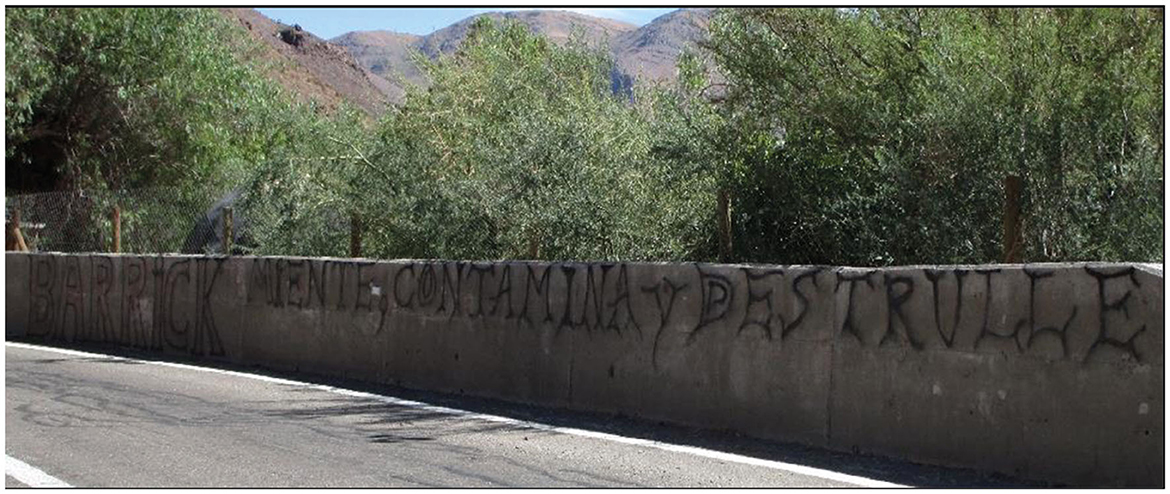
Figure 4. Protests against the mining project: “Barrick lies, contaminates and destroys” (Photo: C. Zang, March 2016).
From the very beginning, the high altitude glaciers have played an important role in the debate (Larraín and Poo, 2010; Urkidi, 2010), because about 20 ha of the planned mining site are covered by the three glaciers Toro 1, Toro 2 and Esperanza. The first Environmental Impact Assessment (EIA) in 2001 proposed to “relocate” these glaciers to neighboring areas (Brenning, 2008; Brenning and Azócar, 2010; Kronenberg, 2013; Taillant, 2015). In this conflict-prone context, local agricultural organizations launched public awareness campaigns to pinpoint the importance of the glaciers for regional hydrology and water supply (Larraín and Poo, 2010). The forecasted impacts included reduced water availability due to overuse, water contamination and health risks. Political and environmental demands were mainly related to the protection of glaciers and water resources as a basis for agricultural activities, discernible by the slogan “mining is death, agriculture is life” (Urkidi and Walter, 2011, p. 688). At the same time, the mining company Barrick Gold has introduced a series of social intervention programs to increase public support among the local population since the early 2000s. This included not only community meetings, training courses and workshops but also sustainable farming and livestock support programs and supplies during the Covid pandemic (Barrick Gold Corporation, 2021).
Given the Chilean water legislation, the mining company requires to hold a significant amount of water rights for project operation. In 2005, a compensation agreement worth about 65 million US$ was concluded with the water management institution Junta de Vigilancia (JdV, Vigilance Committee), which represents all water users, i.e., mostly farmers of the entire Huasco basin. Within the JdV, however, the mining company owns most water rights, which implies a greater level of power and influence in comparison to other users. Two years later, the Diaguita community initiated a legal process in which they claimed territorial rights and access to water (Lorca and Hufty, 2017). They argued for the protection of the glaciers not only as physical landscape features, but as an integral part of their culture (Urkidi and Walter, 2011). On the contrary, the mining company mainly regards water as an economic resource and uses quantifiable, hydrological parameters to substantiate the argument. They have funded and supported a number of scientific projects, including glaciological studies to analyse the impact of mining on glaciers (Nicholson et al., 2009; Gascoin et al., 2011; Rabatel et al., 2011; Arenson et al., 2015; Staub and Munos, 2016). Barrick Gold has further argued that the amount of water needed for the intervention project would be comparatively small on the Chilean site (Urkidi, 2010, p. 223; Li, 2018) thereby legitimizing the potential impacts of the open pit mine. According to official reports, the amount of water used during maintenance work varies between 361,655 m3 in 2015 and 920,050 m3 in 2013, which is only partly released to the environment (Barrick Gold Company, 2015b). In full operation the water usage is estimated to reach 11 million m3 per year, with a share of 5% in the Huasco watershed (Larraín and Poo, 2010). However, this relatively low share corresponds to 25% of the total meltwater runoff from glaciers and seasonal snow cover.
Barrick Gold has frequently faced problems in meeting the environmental regulations of the Chilean government. In addition to insufficient glacier protection, unauthorized abstraction of water and changes to fluvial systems forced the authorities to sanction the company several times (Larraín and Poo, 2010; Li, 2018). In 2013, a channel at the mining site collapsed after a heavy storm and resulted in a flash flood containing unknown concentrations of heavy metals, which affected the upper Huasco valley. Interviewees described how the local discourse evolved about possible impacts of mining activities after the failure of the canal at Pascua Lama. According to some farmers, this water contamination caused deformities of vegetables and people stopped bathing in the river. Yet, hydro-chemical assessments of groundwater and surface water in the El Carmen and El Tránsito valleys in summer 2015/2016 did not indicate adverse effects from measured concentration on human health (Zang et al., 2018).
In addition to this incident, further violations of environmental regulations led to the revocation of Barrick Gold's license to build the mine by the Supreme Court of Chile (Figure 5). The highest legal authority declared the temporary suspension of the project until all environmental regulations would be met, including a new water management system, together with a fine of US$ 16 million (Li, 2018). Maintenance work on the site was still allowed (Barrick Gold Company, 2015c), which led to the expansion of infrastructure in the vicinity of the mine detectable in remote sensing imagery (Figure 6). At the same time, the discourse over the Pascua Lama mine has continued after the first temporal closure of the project in 2013, as the Twitter analysis shows. The number of tweets correlates with events related to the project, with a peak in tweets after significant official decisions on its halt. Most users expressing their views are engaged citizens, people personally attached to the valley, or environmentalists opposed to the project. The mining company irregularly used the social media platform Twitter for expressing their views. Frequently, tweets are used to share and comment on newspaper articles, satellite images of the project area or scientific studies. Social media has also been used to inform people about protest activities, such as the “Marcha por el agua” (March for water), yet this form of activism has declined after the first – at that time preliminary – closure of the mine in 2013.
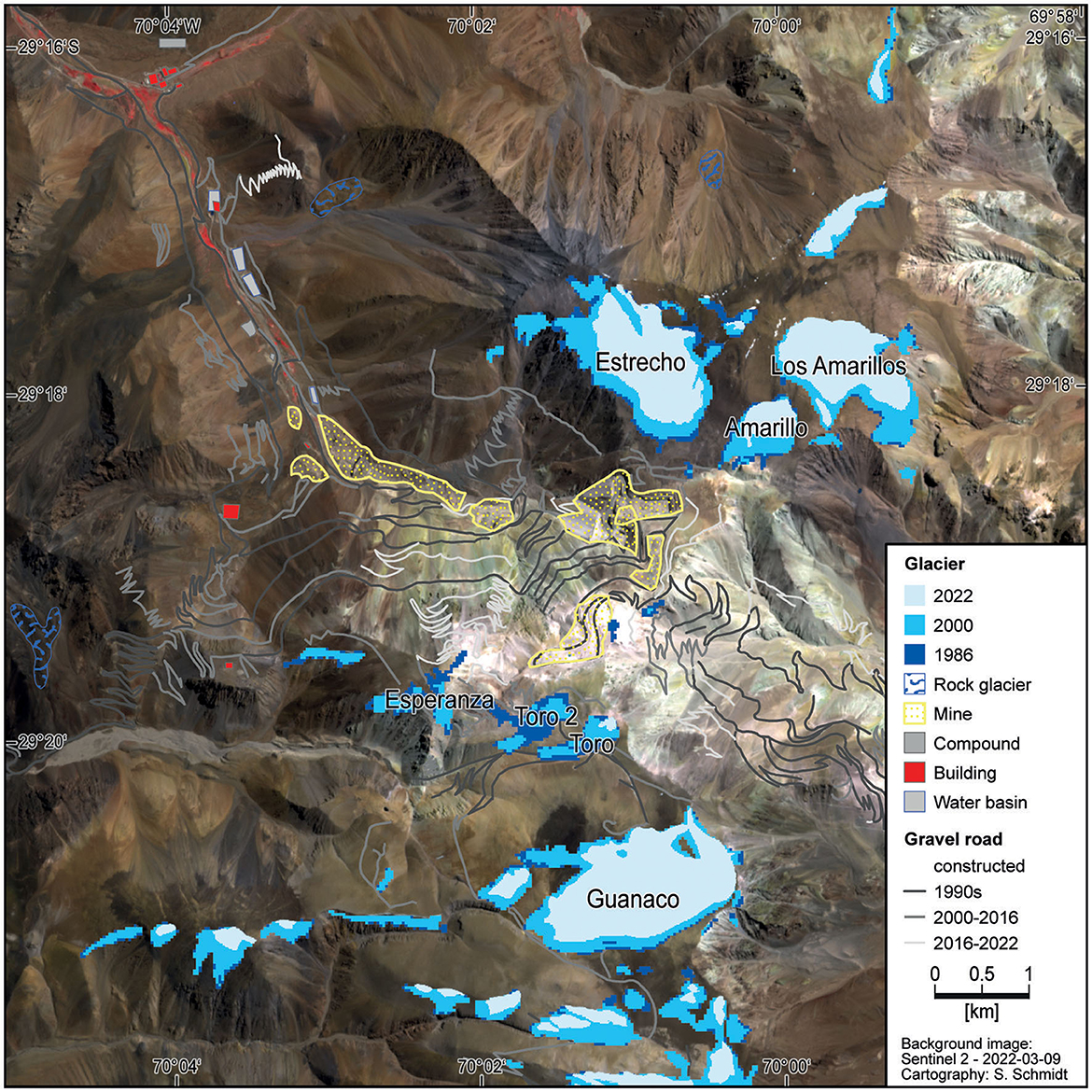
Figure 6. Glacier changes and road constructions in the vicinity of the Pascua Lama project between 1986 and 2022.
In 2015, the Chilean Environmental Court declared that no serious damage was done to the glaciers. However, the remote sensing analysis shows a drastic decline in the glacier-covered area in the vicinity of the Pascua Lama mine by about 35% between 2000 and 2016 (Figure 5, see also Hess et al., 2020). Three glaciers completely disappeared: Toro 2, covering an area of 0.29 km2 in 1986 disappeared before 2016 and the neighboring Esperanza and another glacier covering an area of 0.13 km2 and 0.09 km2 in 1986 vanished between 2016 and 2022. Furthermore, Toro 1 is characterized by a drastic ice cover loss between 1986 and 2016 (0.2 km2 to 0.02 km2) and seems to be relatively stable since 2016. In addition to primary mining activities, a massive expansion of infrastructure, especially gravel roads of varying widths, can be observed in the vicinity of the open pit mine since 2000 (Figure 6). These roads are not only used for transportation of extracted minerals, but also for maintenance operations. The corresponding dust blow and deposits decrease the albedo and further increase melt rates of glaciers. Such processes have been observed in the case of Bello Glacier and Olivares Alpha Glacier in the central Andes of Chile (Cereceda-Balic et al., 2022).
After another extreme weather event and damages to the water treatment plant of the mine in 2016, Barrick Gold announced new plans for underground mining to reduce environmental impacts (Barrick Gold Company, 2017). In 2018, the Chilean environmental authority Superintendencia del Medio Ambiente (SMA) accused Barrick to be responsible of polluting water resources with acidic waste products and non-compliance with monitoring the adjacent glacier fields and finally stopped the project of the Canadian company. Chile's Supreme Court ratified this decision in 2022 and confirmed the halt of the project.
The public discourse over water and glacier changes in the valley is closely related to the Pascua Lama conflict. The word cloud visualizes that most tweets are about Pascua Lama and glaciers, while problems of drought and water scarcity are less frequently broached (Figure 7). The tweets exemplify the different arguments and related meanings of water and glaciers displayed in the discourse over the Pascua Lama project. Activists bring forward the adverse ecological impacts of the mine on water quantity and quality affecting the inhabitants of the valley. The opponents' slogans are repeatedly used on Twitter for example stating that “one cannot eat gold” (own translation). Further, users employ the possessive pronoun “nuestros (ours)” in tweets to define the glacier as common good and call for a change in the legal framework. Resistance against the mining project is verbalized as a fight: it is articulated that mineral extraction affecting glaciers is “an attack against our home” and that the mining company has “killed glaciers” so that they must be “defeated”.
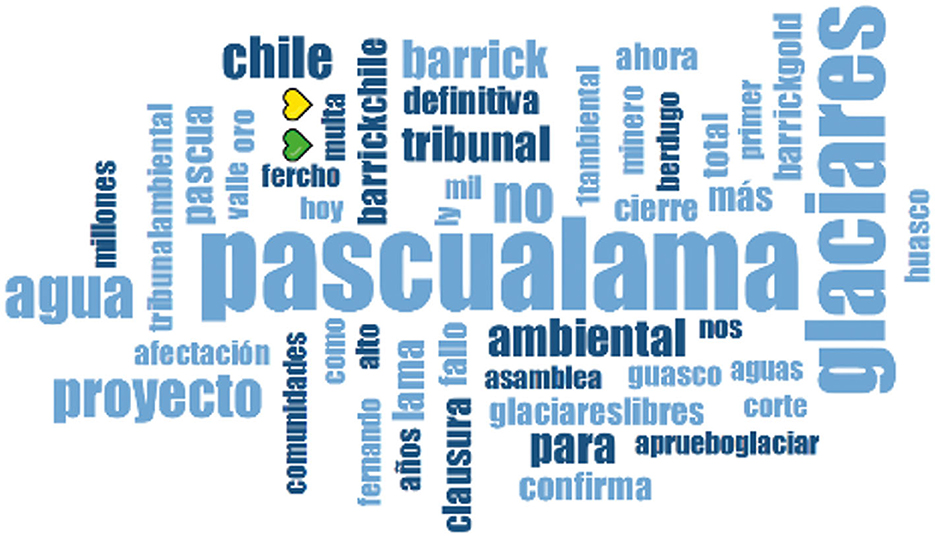
Figure 7. Word cloud derived from a frequency count of Twitter tweets in the original language between 2013 and 2022.
Activists and other twitter users link the resistance to calls for environmental justice and human rights for water. They take the closure of the Pascua Lama mine as a prominent example that may encourage social movements in other politicized environmental conflicts. A tweet issued after the confirmation of the mine closure by Chile's environmental court in 2020 highlights the closure a “citizens' triumph”, at the same time emphasizing the relevance of the glaciers for “the life of ecosystems and the survival of many communities”. In this context, users also employ the slogan “Water is worth more than gold!” Another user argues for the need of an “ecological restauration”. Currently, the mining company is still involved in the closure of the site. After the closure of the mine, agricultural intensification is also addressed as a risk to water resources in the valley. In 2021, one twitter user expresses his or her concern that water resources will “be lost in Avocados”.
Overall, the project is emblematic of difficulties in Chilean water governance (Panez-Pinto et al., 2017; Budds, 2020) and remains a prominent example for socio-hydrological conflicts in the country. Furthermore, mining projects in the upper valley sections impact the glaciers and water resources of the Andean cordillera (Brenning, 2008; Cereceda-Balic et al., 2022). Glacier changes as well as struggles over the control of access and distribution of water are embedded in societal and political processes on multiple scales, highlighting the need for an integrative perspective on mountain waterscapes (Karpouzoglou and Vij, 2017; Müller et al., 2020). In addition to the water quantity, the local population fears negative impacts of water quality caused by the mine, whereas the impact of the agriculture on the water resource is less discussed.
4.2. Agricultural land use
Agriculture is the other central component of the socio-hydrological setting in the valley. Due to the climatic conditions, agricultural production in the region relies on a complex irrigation system, which has been established over the last two centuries. A network of more than 250 canals diverts meltwater from the rivers El Carmen and El Tránsito to the agricultural areas (CAZALAC, 2012). Agricultural land use is generally characterized by a dual structure regarding production mode, socioeconomic settings, and size of landholdings. Small-scale farmers, who produce almost exclusively for subsistence and local markets, dominate agriculture in the upper valley sections. Based on mixed cropping systems and traditional flood irrigation, fruit trees and vegetables (Table 1) are cultivated on small fields. Further downstream, predominantly large-scale export-oriented farms concentrate on table grapes and grapes for liquor production (pisco). Between 1992 and 2015, the cultivated area for grapes has increased from 270 to 1040 ha (ODEPA and CIREN, 1992) (Table 2) mainly due to high global market prices at that time and despite economic risks owing to large price fluctuations as interviewed agricultural producers stated. In order to reduce the risk, some large landowners sold their land to focus on export business including packing and trading of fruits; while most farmers focus on the production of pisco grapes. This characteristic change in agrarian production is driven by the idea to reduce the dependencies on water availability and market prices as interviewees stated. The diversified cultivation of fruits with relatively less water demand (Mekonnen and Hoekstra, 2010), especially citrus fruits, has led to a significant increase in their production. On the other hand, the high water demand of avocado and mango cultivation has resulted in a drastic decrease in area used for these crops and fruits (Table 2).
The agricultural sector of the region has witnessed distinct changes over the last decades. A striking expansion of cultivated areas can be observed in the El Tránsito valley (Figure 8). Dating back until 1973, new infrastructures are detectable in satellite imagery: An 18 km long canal diverts water from the river to the steep slopes and tributaries on the north side of the El Tránsito valley. However, the irrigation of the terraced areas has only been successful in small sections and the cultivation of the tributary has occurred gradually between the 1970s and 2010s (Figure 9). Another expansion of cultivated area has resulted from the straightening of the El Tránsito river over a length of about 10 km between the settlements Alto del Carmen and El Olivo between 1984 and the early 2000s. Thus, several large new fields have been established in close vicinity of the El Tránsito river (Figure 10). Further expansions of about 135 ha took place in El Tránsito valley in the 2000s (Figure 8), when the cultivated area was enlarged onto alluvial fans of small adjoining tributaries in several sections: 40 ha between El Portillo and La Arena (south of El Tránsito), 58 ha nearby La Pampa, 22 ha El Olivo and 27 ha close to Alto del Carmen.
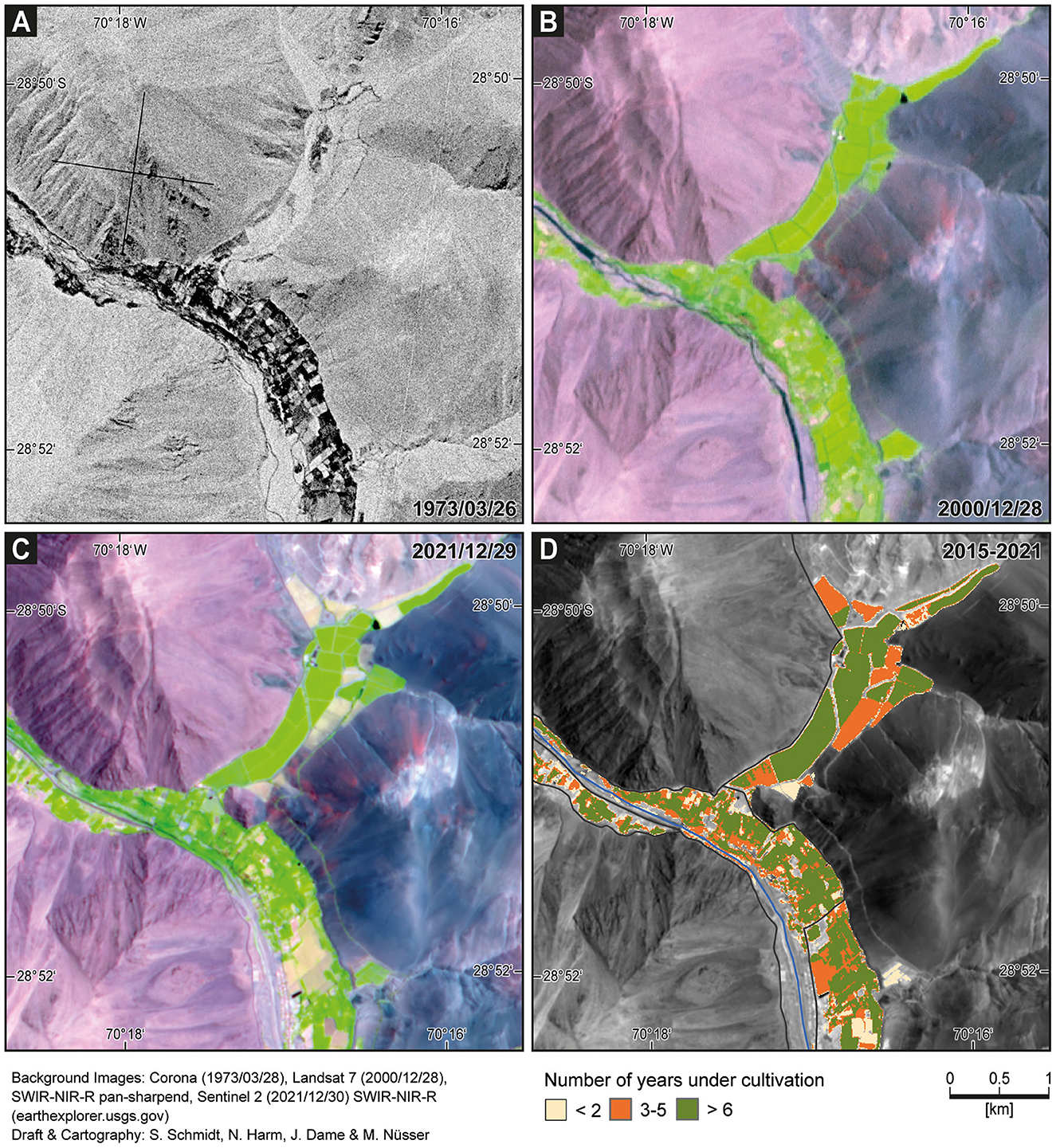
Figure 9. Expansion of export-oriented agricultural areas represented by the large plot size in the tributary of upper Huasco valley between 1973 (A), 2000 (B) and 2021 (C); Number of years under cultivation in recent drought years between 2015 and 2021 (D).
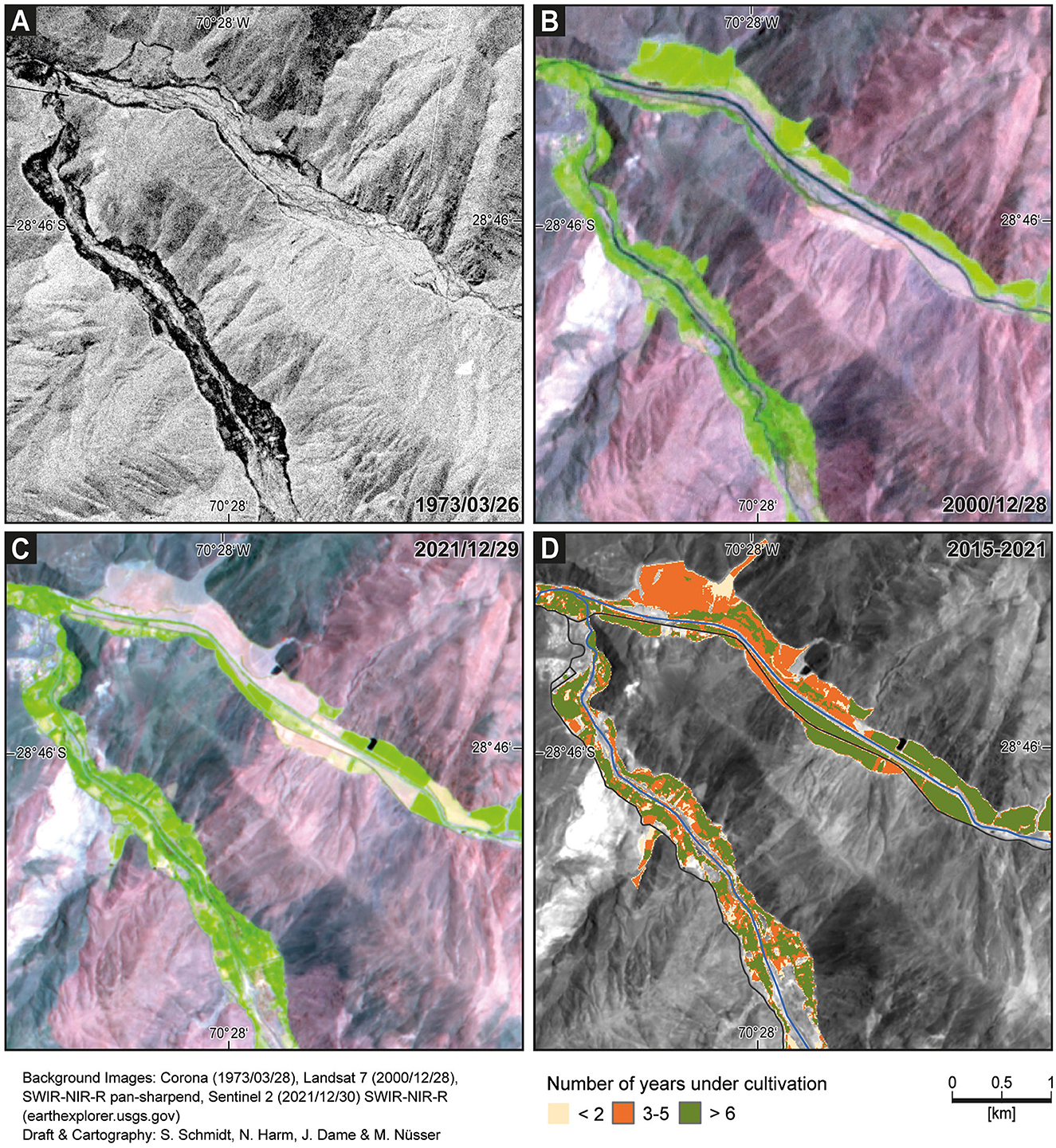
Figure 10. Construction of new cultivated fields in the context of river straightening between 1973 (A), 2000 (B) and 2021 (C); Number of years under cultivation in recent drought years between 2015 and 2021 (D).
In some locations, the transformation from mixed agriculture on smallholder farms to export-oriented agriculture with significantly larger fields can be observed since the mid-1990s. According to interview data, the characteristic decline in the traditional cultivation system comes along with changing employment opportunities in other economic sectors including mining, often regarded as more attractive for the younger generation. This characteristic development can also be observed in other high mountain regions (Grau and Aide, 2007; Dame, 2018; Sugden et al., 2022). As a corresponding result, the remote sensing analysis depicts abandoned plots in the uppermost sections of the Huasco valley. Overall, the total cultivated area has increased from about 2,000 ha in the 1990s to about 3,100 ha in the 2000s. Currently, expansion of agricultural lands has come to a halt and only a slight increase of 100 ha can be detected based on the NDVI over the last decade. Experts expressed to not expect a further increase in the near future mainly due to the uncertainty caused by increasing climatic variability and the scarcity of land suitable for cultivation.
Agricultural expansion and land use changes are accompanied by increasing efforts to improve the efficacy of water management. Regulation of surface water is administered by the JdV. It is regularly abstracted from the main river and diverted along channels to the fields, with user associations (Asociación de canalistas) responsible for water distribution. In recent years, many former channels have been replaced by pipes in order to reduce water infiltration and evaporation. As none of the small tributaries are fed by glacial meltwater and due to their small size, the newly constructed fields depend on river water. In order to get access to water, water rights must be bought in addition to land titles. According to one employee of DGA new water rights are no longer available for inhabitants of the upper Huasco valley, which may also cause a decline in recent land expansions. Beside the amount of water rights, the allocation of water among users depends on the river level. Only under conditions of normal or high river levels, all users can use water according to their full water rights. Due to the recent mega drought, all farmers get less water than they are entitled to and conflicts about water distribution and access between farmers occur as interview partners from CAPR and government agencies described. The mining project still has an impact on water access in the upper Huasco valley, as the company currently holds a majority of water rights and corresponding votes in the JdV. Prospectively, the mining company might sell their water rights in the area, which could lead to further expansion of agricultural production in the entire Huasco valley. Yet, future agricultural intensification bears the risk of increased nitrate concentrations due to the use of chemical fertilizers.
Due to the limited water availability, a transformation from traditional flood irrigation systems to sophisticated drip irrigation techniques can be observed. Mainly export-oriented farmers self-reported the use of drip irrigation, often supported by government actors to counter water shortages. The vulnerability of smallholder farmers remains high (Wagnitz et al., 2014) as only 4 % of them use drip irrigation according to a government agency, whereas the traditional flood irrigation may cause soil salinization, which also adversely affects groundwater resources (Zang et al., 2018). Another adaptation strategy to cope with water insecurity that was mentioned in interviews relates to the construction of water storage ponds, which are mostly used by export-oriented farms. The number of ponds has more than doubled from 25 to 71 between 2000 and 2021. Only few export-oriented farmers have their own bore wells for irrigation purposes, which guarantees additional water supply. In total, only about 63 private bore wells are registered together with related groundwater rights (CAZALAC, 2012). However, according to one director of a CAPR, the exact number of bore wells in the valley and their impact on groundwater level are unknown as there is no public register. This situation potentially threatens future drinking water supply.
Despite the improved irrigation systems, already established in the first years of the recent mega drought, farmers reported that they have been affected by a loss of crops or reduced agricultural produce. Many prune plants and put them into stasis so that they can survive for 2–3 years without additional water. This adaptation strategy can also be detected in remote sensing imagery, showing that only 40% of the total agricultural area has been cultivated every year between 2015 and 2021 (Figures 9–11). Furthermore, the difference between the area under cultivation mentioned in the official data (Table 2) and the extent of agricultural area based on the NDVI can be explained by this drought adaptation measure.
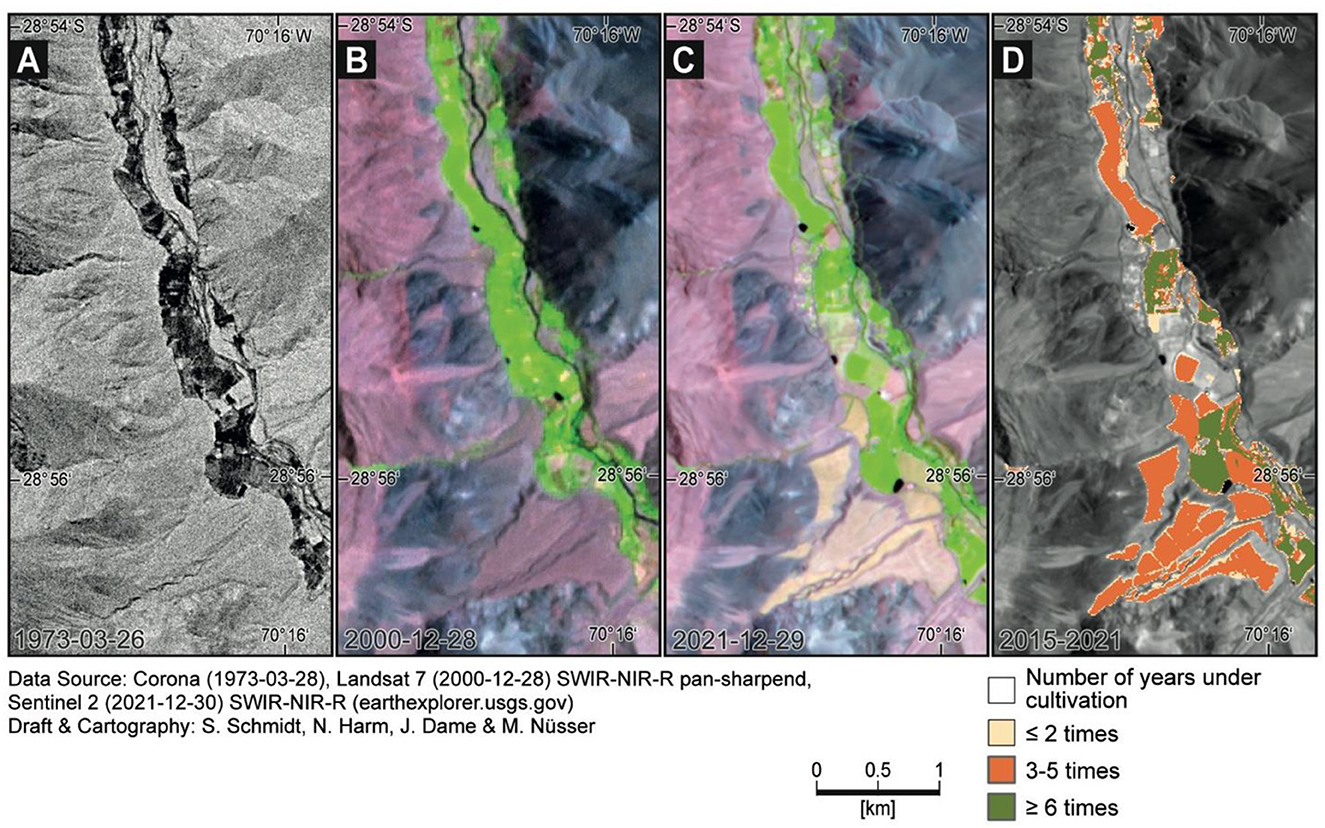
Figure 11. Transformation of former mixed agricultural fields to large fields for the cultivation of cash crops between 1973 (A), 2000 (B) and 2021 (C); Number of years under cultivation in recent drought years between 2015 and 2021 (D).
Overall, the expansion of agriculture leads to an expected increase in water demand as in other arid and semi-arid regions in Chile (Aitken et al., 2016; Roco et al., 2016; Fernández et al., 2019; Muñoz et al., 2020). The remote sensing analysis detected the expansion of irrigated agriculture as well as related infrastructures. Agricultural land use has expanded significantly until 2015, while a mega drought that has affected the country over the past years (Garreaud et al., 2020), resulted in a reduction of agricultural production and the cropping of fruit trees. Other adaptation strategies include the promotion of drip irrigation and the use of plastic-foils in the valley. The cultivation of vineyards, vegetables and horticulture under plastic-foils and nets is an often practiced technique to reduce water loss by evapotranspiration (De Palma et al., 2022). This recent development and corresponding environmental impacts need to be investigated in further studies. Detailed hydrological analyses to assess the impact of drip irrigation on infiltration rates and groundwater recharge are recommended. This would also include detailed assessments of hydrological dynamics with regard to surface water as well as ground water and respective interlinkages in the different watersheds. This is of importance, as within the current legislation a distinction is drawn between surface water and groundwater rights. Future programs should target underlying agro-ecological problems and issues of water governance and not only promote technical solutions as reported in the La Ligua Valley (Budds, 2004).
5. Conclusion
The study shows how water insecurities in the rural area of the upper Huasco valley have mostly been associated with large-scale landscape interventions in the context of the Pascua Lama mine and agricultural land use changes leading to an increase in water demand. Agricultural land use has expanded significantly until 2015, while the mega drought has strongly affected the region over the past years. Water availability largely depends on the cryosphere, which has faced significant changes attributable to climate change and the Pascua Lama mining project. The project has experienced massive resistance resulting from severe violations of environmental regulations and is emblematic for problems in water governance. It remains to be a prominent example of socio-hydrological conflicts in Chile. While assessing the nexus of land use change, cryosphere dynamics and diverse actors, this study highlights the need to consider integrative approaches in water governance reforms. A cross-sectional involvement of actors, participation of local population and civil society actors, close cooperation between different government actors and NGOs are important steps toward environmental justice.
As access to water is generally influenced by the political framing of water privatization, conflicts throughout Chile are often linked to the unequal distribution of water rights and an overuse of the resource (Larraín and Schaeffer, 2015). Recent attempts to reform environmental governance in the context of a new constitution argued for a more just and equitable model of water governance. Based on understanding water as a public good and access to water as a human right, the prioritization of resource use for human consumption was proposed. Focusing on organizational reforms in rural water governance, suggested steps included the installation of watershed committees at the local scale and the establishment of a National Water Agency (Agencia Nacional de Aguas, ANA). In October 2022, the electorates voted for a “rejection” of the proposal. Yet, Chile's water crisis remains a major concern. The impacts of the recent halt of the Pascua Lama project on the development of socio-hydrological interactions of the Huasco valley has yet to be seen.
Data availability statement
The original contributions presented in the study are included in the article/supplementary material, further inquiries can be directed to the corresponding author.
Ethics statement
Ethical review and approval was not required for the study on human participants in accordance with the local legislation and institutional requirements. The patients/participants provided their written informed consent to participate in this study.
Author contributions
JD, MN, and SS: conceptualization, design, writing—review and editing, and contributing to manuscript revision. JD, SS, and CZ: methodology. CZ: field surveys. JD and SS: writing—original draft preparation. JD and MN: supervision of the study. All authors contributed equally to the article and approved the submitted version.
Funding
This study was funded by the Heidelberg Center for the Environment (HCE) at Heidelberg University as part of the Junior Research Group Environment and Health in Arid Regions (D.801000/12.032 ZUK 49/2 5.3.1 HCE, grant holder: JD).
Acknowledgments
We would like to thank Dr. Johanna Höhl (Heidelberg Center Latin America, Santiago de Chile) for continuous support. Laura Meltzer (member of the Junior Research Group and Faculty of Medicine, Heidelberg University) was involved in the questionnaire survey. The survey was reviewed and approved by the ethics board of the Faculty of Medicine at Heidelberg University. Jimena Hevia and Valentina Pineda supported field research in the study area. We would also like to express our gratitude to contact persons and interview partners in the Huasco area who graciously agreed to participate in this study and share their knowledge. Laura Susanne Krieger has carried out an initial Twitter analyses on Pascua Lama. The authors gratefully acknowledge the data storage service SDS@hd supported by the Ministry of Science, Research and the Arts Baden-Württemberg (MWK) and the German Research Foundation (DFG) through grant INST 35/1314-1 FUGG and INST 35/1503-1 FUGG. An earlier version of this paper was presented at the Delft International Conference on Socio-hydrology in September 2021. Conference participation of the first author has generously been supported by a NEWAVE scholarship. We are grateful to the TU Delft Conference on Socio-Hydrology and the Frontiers in Water Journal for supporting the article processing fees. We are also thankful to all the reviewers who reviewed the paper for their timely reviews and helpful comments.
Conflict of interest
The authors declare that the research was conducted in the absence of any commercial or financial relationships that could be construed as a potential conflict of interest.
Publisher's note
All claims expressed in this article are solely those of the authors and do not necessarily represent those of their affiliated organizations, or those of the publisher, the editors and the reviewers. Any product that may be evaluated in this article, or claim that may be made by its manufacturer, is not guaranteed or endorsed by the publisher.
References
Aitken, D., Rivera, D., Godoy-Faúndez, A., and Holzapfel, E. (2016). Water scarcity and the impact of the mining and agricultural sectors in Chile. Sustainability 8, 128. doi: 10.3390/su8020128
Aldunce, P., Araya, D., Sapiain, R., Ramos, I., Lillo, G., Urquiza, A., et al. (2017). Local perception of drought impacts in a changing climate: The mega-drought in central Chile. Sustainability 9, 2053. doi: 10.3390/su9112053
Arenson, L. U., Jakob, M., and Wainstein, P. (2015). “Effects of Dust Deposition on Glacier Ablation and Runoff at the Pascua-Lama Mining Project, Chile and Argentina,” in Engineering Geology for Society and Territory, eds G. Lollino, A. Manconi, J. Clague (Cham: Springer), 27–32.
Ash, J., Kitchin, R., and Leszczynski, A. (2018). Digital turn, digital geographies? Progress Hum. Geography 42, 25–43. doi: 10.1177/0309132516664800
Azócar, G. F., Brenning, A., and Bodin, X. (2017). Permafrost distribution modelling in the semi-arid Chilean Andes. The Cryosphere 11, 877–890. doi: 10.5194/tc-11-877-2017
Bakker, K. J. (2009). Privatizing water, producing scarcity: The Yorkshire drought of 1995*. Econ. Geograph. 76, 4–27. doi: 10.1111/j.1944-8287.2000.tb00131.x
Barrick Gold Company (2015a). Argentina and Chile: Pascua-Lama (Project). Santiago: Barrick Gold Company.
Barrick Gold Company (2015c). Informe - plan de cierre temporal Proyecto Pascua Lama. Santiago: Barrick Gold Company.
Barrick Gold Company (2017). Barrick Sustainability Report 2020. Barrick Gold Company. Available online at: http://www.barrick.com/investors/news/news-details/2017/Barrick-Reports-Progress-on-Projects/default.aspx (accessed November 20, 2017).
Barrick Gold Corporation (2021). Sustainability Report 2021. Human Rights 156. Santiago: Barrick Gold Company.
Bauer, C. J. (1998). Slippery Property Rights: Multiple Water Uses and the Neoliberal Model in Chile, 1981-1995. Natural Resources Journal 38, 109–155.
Bauer, C. J. (2015). Water conflicts and entrenched governance problems in Chile's market model. Water Alternatives 8, 147–172. Available online at: https://www.water-alternatives.org/index.php/alldoc/articles/vol8/v8issue2/285-a8-2-8 (accessed November 22, 2022).
BCN (2021). Comuna Alto del Carmen. Bcn.Cl. Available online at: https://www.bcn.cl/siit/reportescomunales/comunas_v.html?anno=2021andidcom=3302 (accessed November 22, 2022).
Blair, P., and Buytaert, W. (2016). Socio-hydrological modelling: A review asking “why, what and how?” Hydrol. Earth Syst. Sci. 20, 443–478. doi: 10.5194/hess-20-443-2016
Boelens, R. (2014). Cultural politics and the hydrosocial cycle: Water, power and identity in the Andean highlands. Geoforum 57, 234–247. doi: 10.1016/j.geoforum.2013.02.008
Boelens, R., Hoogesteger, J., Swyngedouw, E., Vos, J., and Wester, P. (2016). Hydrosocial territories: A political ecology perspective. Water Int. 41, 1–14. doi: 10.1080/02508060.2016.1134898
Bottaro, L., Latta, A., and Sola, M. (2014). La politización del agua en los conflictos por la megaminería: Discursos y resistencias en Chile y Argentina. Eur. Rev. Latin 7, 97–115. doi: 10.18352/erlacs.9798
Brenning, A. (2008). “The impact of mining on rock glaciers and glaciers: Examples from Central Chile,” in Darkening Peaks: Glacier Retreat, Science, and Society, eds E. W. Orlove, E. Wiegandt, E., and B. H. Luckmann (California: University of California Press), 196–205.
Brenning, A., and Azócar, G. F. (2010). Minería y glaciares rocosos: Impactos ambientales, antecedentes políticos y legales, y perspectivas futuras. Revista de Geografía Norte Grande 47, 143–158. doi: 10.4067/S0718-34022010000300008
Buckingham, K., Brandt, J., Anderson, W., do Amaral, L. F., and Singh, R. (2020). The untapped potential of mining news media events for understanding environmental change. Curr. Opinion Environ. Sustainability 45, 92–99. doi: 10.1016/j.cosust.2020.08.015
Budds, J. (2004). Power, nature and neoliberalism: The political ecology of water in Chile. Singapore J. Trop. Geograph. 25, 322–342. doi: 10.1111/j.0129-7619.2004.00189.x
Budds, J. (2009). Contested H2O: Science, policy and politics in water resources management in Chile. Geoforum 40, 418–430. doi: 10.1016/j.geoforum.2008.12.008
Budds, J. (2013). Water, power, and the production of neoliberalism in Chile, 1973–2005. Environ. Planning D: Society and Space 31, 301–318. doi: 10.1068/d9511
Budds, J. (2020). Securing the market: Water security and the internal contradictions of Chile's Water Code. Geoforum 113, 165–175. doi: 10.1016/j.geoforum.2018.09.027
Budds, J., and Hinojosa, L. (2012). Restructuring and rescaling water governance in mining contexts: The co-production of waterscapes in Peru. Water Alternatives 5, 119–137. Available online at: https://www.water-alternatives.org/index.php/alldoc/articles/vol5/v5issue1/161-a5-1-8 (accessed November 22, 2022).
Carey, M., Molden, O. C., Rasmussen, M. B., Jackson, M., Nolin, A. W., Mark, B. G., et al. (2017). Impacts of glacier recession and declining meltwater on mountain societies. Annal. Am. Assoc. Geographers 107, 350–359. doi: 10.1080/24694452.2016.1243039
CAZALAC (2012) Model para la gestion hidrica de la cuenca de Huasco: Evaluacion de caudal ambiental y valoracion de servicios hidrologicos. Vallenar: CAZALAC.
Cereceda-Balic, F., Ruggeri, M. F., Vidal, V., Ruiz, L., and Fu, J. S. (2022). Understanding the role of anthropogenic emissions in glaciers retreat in the central Andes of Chile. Environ. Res. 214, 113756. doi: 10.1016/j.envres.2022.113756
CNR (2006). Estudio de calidad de aguas subterráneas en las cuencas de Huasco y Mataquito. Santiago de Chile.
Dame, J. (2018). Food security and translocal livelihoods in high mountains: Evidence from Ladakh, India. Mt. Res. Dev. 38, 310–322. doi: 10.1659/mrd-journal-d-18-00026.1
De Palma, D., Vox, L., Schettini, G. E., and Novello, V. (2022). Reduction of evapotranspiration in microenvironment conditions of table grape vineyards protected by different types of plastic covers. Agronomy 12, 600. doi: 10.3390/agronomy12030600
DGA (2004). Cuenca del Río Huasco: Diagnóstico y classificación de los cursos y cuerpos de agua según objetivos de calidad.
DGA (2016) Informacion oficial hidrometerologica y de caldidad de aguas en linea. Available online at: http://snia.dga.cl/BNAConsultas/reportes (accessed January 27, 2015).
Di Baldassarre, G. (2017). Socio-hydrology of floods. Oxford Res. Encyc. Nat. Hazard Sci. 4, 264 doi: 10.1093/acrefore/9780199389407.013.264
Donoso, G., and Vicuña, S. (2016). Aseguramiento Responsable del Agua Para Consumo Humano. Technical Report, Informe final. Santiago: Centro de Cambio Global UC.
EJAtlas (2022). Global Atlas of Environmental Justice. Available online at: https://ejatlas.org/ (accessed October 18, 2022).
Falvey, M., and Garreaud, R. (2007). Wintertime precipitation episodes in central Chile: Associated meteorological conditions and orographic influences. J. Hydrometeorology 8, 171–193. doi: 10.1175/JHM562.1
Favier, V., Falvey, M., Rabatel, A., Praderio, E., and López, D. (2009). Interpreting discrepancies between discharge and precipitation in high-altitude area of Chile's Norte Chico region (26-32°S). Water Res. Res. 45, W02424. doi: 10.1029/2008WR006802
Fearnley, F., and Fyfe, R. (2018). Twitter: An emerging source for geographical study. Geography 103, 97–101. doi: 10.1080/00167487.2018.12094044
Fernández, F. J., Blanco, M., Ponce, R. D., Vásquez-Lavín, F., and Roco, L. (2019). Implications of climate change for semi-arid dualistic agriculture: A case study in Central Chile. Reg. Environ. Change 19, 89–100. doi: 10.1007/s10113-018-1380-0
Fiebig-Wittmaack, M., Astudillo, O., Wheaton, E., Wittrock, V., Perez, C., and Ibacache, A. (2012). Climatic trends and impact of climate change on agriculture in an arid Andean valley. Climatic Change 111, (3–4) 819–833. doi: 10.1007/s10584-011-0200-z
Flaminio, S., Rouillé-Kielo, G., and Le Visage, S. (2022). Waterscapes and hydrosocial territories: Thinking space in political ecologies of water. Prog. Environ. Geography 1, 33–57. doi: 10.1177/27539687221106796
Garreaud, R. D., Boisier, J. P., Rondanelli, R., Montecinos, A., Sepúlveda, H. H., and Veloso-Aguila, D. (2020). The central Chile mega drought (2010–2018): A climate dynamics perspective. Int. J. Climatol. 40, 421–439. doi: 10.1002/joc.6219
Gascoin, S., Kinnard, C., Ponce, R., Lhermitte, S., MacDonell, S., and Rabatel, A. (2011). Glacier contribution to streamflow in two headwaters of the Huasco River, Dry Andes of Chile. The Cryosphere 5, 1099–1113. doi: 10.5194/tc-5-1099-2011
Gordon, T., and Webber, J. R. (2008). Imperialism and resistance: Canadian mining companies in Latin America. Third World Quarterly 29, 63–87. doi: 10.1080/01436590701726509
Grau, H. R., and Aide, T. M. (2007). Are rural–urban migration and sustainable development compatible in mountain systems? Mt. Res. Dev. 27, 119–123. doi: 10.1659/mrd.0906
Haeffner, M., Hellman, D., Cantor, A., Ajibade, I., Oyanedel-Craver, V., Kelly, M., et al. (2021). Representation justice as a research agenda for socio-hydrology and water governance. Hydrol. Sci. J. 66, 1611–1624. doi: 10.1080/02626667.2021.1945609
Hess, K., Schmidt, S., Nüsser, M., Zang, C., and Dame, J. (2020). Glacier changes in the semi-arid Huasco Valley, Chile, between 1986 and 2016. Geosciences 10, 429. doi: 10.3390/geosciences10110429
Karpouzoglou, T., and Vij, S. (2017). Waterscape: A perspective for understanding the contested geography of water. WIREs Water 4, e1210. doi: 10.1002/wat2.1210
Kronenberg, J. (2013). Linking ecological economics and political ecology to study mining, glaciers and global warming: Mining, glaciers and global warming. Environ. Policy Gov. 23, 75–90. doi: 10.1002/eet.1605
Krueger, T., Maynard, C., Carr, G., Bruns, A., Mueller, E. N., and Lane, S. (2016). A transdisciplinary account of water research. WIREs Water 3, 369–389. doi: 10.1002/wat2.1132
Kuckartz, U. (2014). Qualitative Text Analysis: A Guide to Methods, Practice and Using Software. London, United Kingdom: SAGE
Larraín, S., and Poo, P. (2010). Conflictos porael Agua en Chile: Entre los Derechos Humanos y las Reglas del Mercado. Santaigo: Heinrich Böll-Stiftung.
Larraín, S., and Schaeffer, C. (2015). Conflicts Over Water in Chile: Between Human Rights and Market Rules. Available online at: https://www.chilesustentable.net/wp-content/uploads/2015/06/Conflicts-over-Water-in-Chile.pdf (accessed June 4, 2015).
Li, F. (2018). Moving glaciers: Remaking nature and mineral extraction in Chile. Latin Am. Perspectives 45, 102–119. doi: 10.1177/0094582X17713757
Linton, J., and Budds, J. (2014). The hydrosocial cycle: Defining and mobilizing a relational-dialectical approach to water. Geoforum 57, 170–180. doi: 10.1016/j.geoforum.2013.10.008
Lorca, M., and Hufty, M. (2017). El patrimonio como forma de resistencia a la gran minería: El caso del Huasco Alto, Chile. Intersecciones en Antropología. 18, 31–42. Available online at: http://www.scielo.org.ar/scielo.php?script=sci_arttext&pid=S1850-373X2017000100003 (accessed February 28, 2023)
Masiokas, M. H., Rabatel, A., Rivera, A., Ruiz, L., Pitte, P., Ceballos, J. L., et al. (2020). A review of the current state and recent changes of the Andean cryosphere. Front. Earth Sci. 8, 99. doi: 10.3389/feart.2020.00099
Mekonnen, M. M., and Hoekstra, A. Y. (2010). The Green, Blue and Grey Water Footprint of Crops and Derived Crop Products. Delft Available online at: https://www.waterfootprint.org/media/downloads/Report47-WaterFootprintCrops-Vol1.pdf (accessed November 12, 2022).
Meltzer, L., Dame, J., and Gabrysch, S. (2021). Flood affectedness and household adaptation measures in rural northern Chile: A cross-sectional study in the Upper Huasco Valley. Int. J. Disaster Risk Reduction 64, 102499. doi: 10.1016/j.ijdrr.2021.102499
Molina Otárola, R., and Campos Muñoz, L. (2017). Confín geográfico, refugio indígena, pueblo de indios y etnogénesis en el Huasco Alto, (Chile). Revista de Geografía Norte Grande. 68, 123–140. doi: 10.4067/S0718-34022017000300123
MOP (2022). Decreto N° 257. Declara zona de escasez a la comuna a la cummuna de Alto del Carmen, Provincia de Huasco, región de Atacama. Santiago: MOP.
Müller, J., Dame, J., and Nüsser, M. (2020). Urban Mountain Waterscapes: The transformation of hydro-social relations in the Trans-Himalayan town Leh, Ladakh, India. Water 12, 1698. doi: 10.3390/w12061698
Muñoz, A. A., Klock-Barría, K., Alvarez-Garreton, C., Aguilera-Betti, I., González-Reyes, Á., Lastra, J. A., et al. (2020). Water crisis in Petorca Basin, Chile: The combined effects of a mega-drought and water management. Water 12, 648. doi: 10.3390/w12030648
Nicholson, L., Marín, J., Lopez, D., Rabatel, A., Bown, F., and Rivera, A. (2009). Glacier inventory of the upper Huasco valley, Norte Chico, Chile: Glacier characteristics, glacier change and comparison with central Chile. Annal. Glaciol. 50, 111–118. doi: 10.3189/172756410790595787
Nüsser, M. (2017). Socio-hydrology: A new perspective on mountain waterscapes at the nexus of natural and social processes. Mountain Res. Dev. 37, 518–520. doi: 10.1659/MRD-JOURNAL-D-17-00101.1
Nüsser, M., and Baghel, R. (2016). “Local Knowledge and Global Concerns: Artificial Glaciers as a Focus of Environmental Knowledge and Development Interventions,” in Ethnic and Cultural Dimensions of Knowledge Knowledge and Space, eds P. Meusburger, T. Freytag, and L. Suarsana (Dordrecht; Heidelberg: Springer), 191–209.
Nüsser, M., Dame, J., Kraus, B., Baghel, R., and Schmidt, S. (2019a). Socio-hydrology of “artificial glaciers” in Ladakh, India: Assessing adaptive strategies in a changing cryosphere. Reg. Environ. Change 19, 1327–1337. doi: 10.1007/s10113-018-1372-0
Nüsser, M., Dame, J., Parveen, S., Kraus, B., Baghel, R., and Schmidt, S. (2019b). Cryosphere-fed irrigation networks in the northwestern himalaya: Precarious livelihoods and adaptation strategies under the impact of climate change. Mountain Res. Dev. 39, 1–14. doi: 10.1659/MRD-JOURNAL-D-18-00072.1
Nüsser, M., and Schmidt, S. (2017). Nanga Parbat revisited: Evolution and dynamics of socio-hydrological interactions in the Northwestern Himalaya. Annal. Am. Assoc. Geographers 107, 403–415. doi: 10.1080/24694452.2016.1235495
Nüsser, M., Schmidt, S., and Dame, J. (2012). Irrigation and development in the upper Indus basin: Characteristics and recent changes of a socio-hydrological system in Central Ladakh, India. Mountain Res. Dev. 32, 51–61. doi: 10.1659/MRD-JOURNAL-D-11-00091.1
ODEPA (2019). Panorama de la Agricultura Chilena-2019/Chilean agriculture overview. ODEPA: Santiago.
ODEPA and CIREN (1992). Resultados Preliminares Catastro Frutícola, Región Atacama. Chile: Ministerio de Agricultura Chile.
Oyarzún, R., Arumi, J. L., Alvarez, P., and Rivera, D. (2008). “Water use in the Chilean agriculture: Current situation and areas for research development,” in Agricultural Water Management Research Trends, eds M. L. Sørensen (New York, NY: Nova Science Publishers), 213–236.
Pande, S., and Savenije, H. H. G. (2016). A sociohydrological model for smallholder farmers in Maharashtra, India. Water Res. Research 52, 1923–1947. doi: 10.1002/2015WR017841
Pande, S., and Sivapalan, M. (2017). Progress in socio-hydrology: A meta-analysis of challenges and opportunities. WIREs Water 4, 1193. doi: 10.1002/wat2.1193
Panez-Pinto, A., Faúndez-Vergara, R., and Mansilla-Quiñones, C. (2017). Politización de la crisis hídrica en Chile: Análisis del conflicto por el agua en la provincia de Petorca. Agua y Territorio 131, 3614. doi: 10.17561/at.10.3614
Parveen, S., Winiger, M., Schmidt, S., and Nüsser, M. (2015). Irrigation in Upper Hunza: Evolution of socio-hydrological interactions in the Karakoram, northern Pakistan. Erdkunde 69, 69–85. doi: 10.3112/erdkunde.2015.01.05
Paul, F., Barry, R. G., Cogley, J. G., Frey, H., Haeberli, W., Ohmura, A., et al. (2009). Recommendations for the compilation of glacier inventory data from digital sources. Annal. Glaciol. 50, 119–126. doi: 10.3189/172756410790595778
Prieto, M. (2015). Privatizing water in the Chilean Andes: The case of Las Vegas de Chiu-Chiu. Mountain Res. Dev. 35, 220–229. doi: 10.1659/MRD-JOURNAL-D-14-00033.1
Prieto, M. (2016). Practicing costumbres and the decommodification of nature: The Chilean water markets and the Atacameño people. Geoforum 77, 28–39. doi: 10.1016/j.geoforum.2016.10.004
Rabatel, A., Castebrunet, H., Favier, V., Nicholson, L., and Kinnard, C. (2011). Glacier changes in the Pascua-Lama region, Chilean Andes (29° S): Recent mass balance and 50 yr surface area variations. The Cryosphere 5, 1029–1041. doi: 10.5194/tc-5-1029-2011
Roco, L., Poblete, D., Meza, F., and Kerrigan, G. (2016). Farmers' options to address water scarcity in a changing climate: Case studies from two basins in mediterranean Chile. Environ. Manage. 58, 958–971. doi: 10.1007/s00267-016-0759-2
Roobavannan, M., Kandasamy, J., Pande, S., Vigneswaran, S., and Sivapalan, M. (2017). Role of sectoral transformation in the evolution of water management norms in agricultural catchments: A sociohydrologic modeling analysis. Water Res. Research 53, 8344–8365. doi: 10.1002/2017WR020671
Ross, A., and Chang, H. (2020). Socio-hydrology with hydrosocial theory: Two sides of the same coin? Hydrol. Sciences Journal 65, 1443–1457. doi: 10.1080/02626667.2020.1761023
Salas, I., Herrera, C., Luque, J. A., Delgado, J., Urrutia, J., and Jordan, T. (2016). Recent climatic events controlling the hydrological and the aquifer dynamics at arid areas: The case of Huasco river watershed, northern Chile. Sci. Total Environ. 571, 178–194. doi: 10.1016/j.scitotenv.2016.07.132
Salinas, B. (2007). Implicancias territoriales del conflicto Pascua Lama, Valle del Huasco, región de Atacama. Santiago: Universidad de Chile, Santiago de Chile.
Schmidt, S., Nüsser, M., Baghel, R., and Dame, J. (2020). Cryosphere hazards in Ladakh: The 2014 Gya glacial lake outburst flood and its implications for risk assessment. Natural Hazards 104, 2071–2095. doi: 10.1007/s11069-020-04262-8
SERNAGEOMIN (2022). Anuario de la Minería de Chile 2021. Servicio Nacional de Geología y Minería. Santiago de Chile: SERNAGEOMIN.
Sivapalan, M. (2015). Debates—Perspectives on socio-hydrology: Changing water systems and the “tyranny of small problems”—Socio-hydrology. Water Res. Res. 51, 4795–4805. doi: 10.1002/2015WR017080
Sivapalan, M., Konar, M., Srinivasan, V., Chhatre, A., Wutich, A., Scott, C. A., et al. (2014). Socio-hydrology: Use-inspired water sustainability science for the Anthropocene. Earth's Future 2, 225–230. doi: 10.1002/2013EF000164
Sivapalan, M., Savenije, H. H. G., and Blöschl, G. (2012). Socio-hydrology: A new science of people and water. Hydrol. Proc. 26, 1270–1276. doi: 10.1002/hyp.8426
Staub, G., and Munos, C. (2016). Climate Factors' Effects on Glacier Variations in the Commune of Alto del Carmen, Chile. Environmental Applications of Remote Sensing. Rijeka: InTech.
Strauch, G., Oyarzún, R., Reinstorf, F., Oyarzún, J., Schirmer, M., and Knöller, K. (2009). Interaction of water components in the semi-arid Huasco and Limarí river basins, North Central Chile. Adv. Geosci. 22, 51–57. doi: 10.5194/adgeo-22-51-2009
Sugden, F., Nigussie, L., Debevec, L., and Nijbroek, R. (2022). Migration, environmental change and agrarian transition in upland regions: learning from Ethiopia, Kenya and Nepal. J. Peasant Stud. 49, 1101–1131. doi: 10.1080/03066150.2021.1894552
Swyngedouw, E. (1997). “Neither Global nor Local: “Glocalization” and the Politics of Scale,” in Spaces of Globalization: Reasserting the Power of the Local, ed K. R. Cox (New York, NY: Guilford Press), 137–166.
Troy, T. J., Pavao-Zuckerman, M., and Evans, T. P. (2015). Debates—Perspectives on socio-hydrology: Socio-hydrologic modeling: Tradeoffs, hypothesis testing, and validation. Water Res. Res. 51, 4806–4814. doi: 10.1002/2015WR017046
Urkidi, L. (2010). A glocal environmental movement against gold mining: Pascua–Lama in Chile. Ecol. Econ. 70, 219–227. doi: 10.1016/j.ecolecon.2010.05.004
Urkidi, L., and Walter, M. (2011). Dimensions of environmental justice in anti-gold mining movements in Latin America. Geoforum 42, 683–695. doi: 10.1016/j.geoforum.2011.06.003
Usón, T. J., Henríquez, C., and Dame, J. (2017). Disputed water: Competing knowledge and power asymmetries in the Yali Alto basin, Chile. Geoforum 85, 247–258. doi: 10.1016/j.geoforum.2017.07.029
Valdés-Pineda, R., Pizarro, R., García-Chevesich, P., Valdés, J. B., Olivares, C., Vera, M., et al. (2014). Water governance in Chile: Availability, management and climate change. J. Hydrol. 519, 2538–2567. doi: 10.1016/j.jhydrol.2014.04.016
Vicuña, S., McPhee, J., and Garreaud, R. D. (2012). Agriculture vulnerability to climate change in a snowmelt-driven basin in semiarid Chile. J. Water Res. Planning Manage. 138, 431–441. doi: 10.1061/(ASCE)WR.1943-5452.0000202
Viglione, A., Di Baldassarre, G., Brandimarte, L., Kuil, L., Carr, G., Salinas, J. L., et al. (2014). Insights from socio-hydrology modelling on dealing with flood risk – Roles of collective memory, risk-taking attitude and trust. J. Hydrology 518, 71–82. doi: 10.1016/j.jhydrol.2014.01.018
Wagnitz, P., Núñez, J., and Ribbe, L. (2014). Cost of environmental flow during water scarcity in the arid Huasco River basin, northern Chile. Hydrol. Sci. J. 59, 700–711. doi: 10.1080/02626667.2014.892599
Wesselink, A., Kooy, M., and Warner, J. (2017). Socio-hydrology and hydrosocial analysis: Toward dialogues across disciplines. Water 4, e1196. doi: 10.1002/wat2.1196
Yu, D. J., Haeffner, M., Jeong, H., Pande, S., Dame, J., Baldassarre, D., et al. (2022). On capturing human agency and methodological interdisciplinarity in socio-hydrology research. Hydrol. Sci. J. 67, 1905–1916. doi: 10.1080/02626667.2022.2114836
Zanetta-Colombo, N. C., Fleming, Z. L., Gayo, E. M., Manzano, C. A., Panagi, M., Valdés, J., et al. (2022). Impact of mining on the metal content of dust in indigenous villages of northern Chile. Environ. Int. 169, 107490. doi: 10.1016/j.envint.2022.107490
Keywords: socio-hydrology, land use change, mining, water insecurity, Pascua Lama, Andes, water governance, glacier change
Citation: Dame J, Nüsser M, Schmidt S and Zang C (2023) Socio-hydrological dynamics and water conflicts in the upper Huasco valley, Chile. Front. Water 5:1100977. doi: 10.3389/frwa.2023.1100977
Received: 17 November 2022; Accepted: 25 May 2023;
Published: 20 June 2023.
Edited by:
Melissa Haeffner, Portland State University, United StatesReviewed by:
Hanne Wiegel, Wageningen University and Research, NetherlandsJohn Ndiritu, University of the Witwatersrand, South Africa
Pedro A. Hervé-Fernández, Universidad Adolfo Ibáñez, Chile
Copyright © 2023 Dame, Nüsser, Schmidt and Zang. This is an open-access article distributed under the terms of the Creative Commons Attribution License (CC BY). The use, distribution or reproduction in other forums is permitted, provided the original author(s) and the copyright owner(s) are credited and that the original publication in this journal is cited, in accordance with accepted academic practice. No use, distribution or reproduction is permitted which does not comply with these terms.
*Correspondence: Juliane Dame, anVsaWFuZS5kYW1lQHVuaS1oZWlkZWxiZXJnLmRl
†These authors have contributed equally to this work and share first authorship
 Juliane Dame
Juliane Dame Marcus Nüsser
Marcus Nüsser Susanne Schmidt
Susanne Schmidt Carina Zang1,3†
Carina Zang1,3†